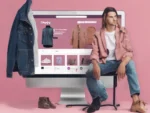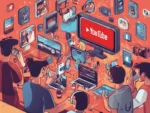One of the great maxims of our culture is that nothing stays the same. Trends are a part of life, whether it’s fashion, communications, or even architecture. People even talk about trends, especially as they impact everyday life. And, in the last couple of decades, social media trends have become a growing concern for consumers and marketers alike. In this article, we’ll look at the major trends we’re seeing this year. Hopefully, this will help to guide your decision-making.
The Social Media Economy Expands
Among the 2025 social media trends, we do recognize a pattern: the social media economy is expanding. For our purposes, the social media economy involves people spending and making money online. This can include monetizing content, shopping, subscriptions, advertising, and more. Let’s take a look at this category of developments.
1. Social Media Becoming a Stronger Shopping Platform
Since the pandemic started, social media has evolved from a relatively minor shopping platform to a significant economic force. For instance, people are happier to buy things through social media functions such as shoppable Instagram posts and clicking through social ads. In addition, Facebook Messenger has a larger role in customer service and purchasing than ever.
Furthermore, according to Forbes Magazine, experts contend that social media trends towards social selling will increase rapidly. This is one thing where China was ahead of the curve before 2020, but America is expected to continue closing the gap. Perhaps this isn’t surprising, though, given the increased importance of influencers for customer acquisition.
2. Paid Social Media Continues to Increase
Similarly, brands are meeting the trends by spending more on social media advertising. Especially since networks like Facebook have long since placed organic branded content at a disadvantage, this is one of the more long-term social media trends. Ad spending has risen steadily for many years, and marketers expect the trend to continue over the long term. Brands that don’t advertise on social media are missing out on a lot of potential revenue.
3. Boom of Creator Economy / Brand Collaboration with Content Creators / Nano and Micro Influencers
If you’ve spent a significant amount of time on YouTube, you’ve probably noticed that a lot of channels are monetized. Whether that is a subscription through YouTube, an outside sponsorship site, or even branded collaborations.
Speaking of collaborations on YouTube, this concept isn’t new. In fact, it was the rise of influencer marketing that helped create the concept of paid sponsorships. It used to be that social media content creators either published content to be famous or to keep track of their network. Monetization options were minimal at best.
The rise of influencer marketing changed everything in this regard. Companies found that influencers would talk about products, and their followers would often buy them. Over time, influencers started getting paid sponsorships because brands saw the value of these advertisements. Influencer marketing spending has grown to the extent that some companies spend a large part of their marketing budget on it. In addition, even influencers with relatively small subscriber bases are now part of the marketing scene.
This trend has continued: as more brands hunger for more content, content creators are finding new ways to monetize their followings, including course creation and NFTs. Content isn’t so much about content marketing or exposure anymore. Increasingly, content creation is a side gig and even a full-time job.
Further Reading: 33 Mind-Blowing Creator Economy Statistics for 2025
Video

While social media started out as a primary text and graphics-based medium, it has long since grown beyond these boundaries. Nowadays, social media includes videos of all lengths and types. Some are elaborate, while others can be taken with a smartphone and posted right away. The options are endless, so it’s unsurprising that video content makes up some of the social media trends for 2025.
4. Continued Domination of Video Content
According to YouTube, users watch an impressive 1 billion hours of content daily. Considering the total world population, this means that on average everyone watches YouTube every day. It’s even more impressive when you consider that a large percentage of YouTube hours are consumer-generated. Branded content made by companies is also prevalent, but you can see the power that YouTube has overall.
However, YouTube isn’t the only show in town for video content. There’s Facebook Live, Vimeo, Instagram, and many more platforms. Added together, the potential for people and brands to distinguish themselves through video is incredible.
5. Short-form Video Content is Still Booming
Short-form content options include YouTube Shorts, Instagram Reels, TikTok, Pinterest Idea Pins, and Google Web Stories. Many of these options, like TikTok and YouTube Shorts, have emerged over the last few years. And while YouTube Shorts is an expansion of an existing platform, TikTok is something we hadn’t heard of until recently. In a free marketplace, new opportunities are bound to crop up whenever there’s money to be made. The very existence of newer video content options shows that video remains one of the big social media trends.
Let’s look at this another way. TikTok took the world by storm when it branched out from the Chinese mainland. It’s young and hip, with a very young demographic. Unfortunately, it has also led to a lot of hazardous behavior to gain views. Nonetheless, there’s an increasing number of TikTok content creators who are paid influencers. If a short-form video wasn’t still cool, advertisers wouldn’t have started working with TikTok influencers.
Further Reading: The 11 Types of Short-Form Video You Can Leverage TODAY
Brand Accountability in Social Media
The COVID pandemic brought us all closer to each other through social media, and social media has become a bigger and bigger part of every social movement that has happened since. Beginning with Black Lives Matter, we know to see how companies are going to react to world events. More recently, businesses are taking to social media to announce their boycotts on Russia and show their support for Ukraine. Regardless of how you see it, there is no doubt that social media users are holding brands more accountable in social media, and many brands are responding positively to this trend.
6. Increased Calls for Brand Accountability and Social Awareness
Once upon a time, brands could pretend to not care about anything going on in the world. They didn’t have to take a stand on social issues, and nobody really cared how they treated their employees. However, times have changed. One of the biggest social media trends is calling out brands for their stand on different social issues. Having the wrong position on some things can even get a brand “canceled.” Many events over the last two years have shown the extent to which this is true.
However, it isn’t just about social justice issues. Rather, people want to know if a company is transparent about its supply chains. Some major brands have gotten into a lot of trouble with consumers about bad labor practices. Wal-Mart and Apple are great examples: Wal-Mart gets pressurized for low wages, and Apple is often accused of using factories with poor working conditions. In both cases, the war is waged on social media in addition to other forums.
7. Renewed Focus on Inclusivity & Diversity
These days, when companies commit a perceived injustice against an employee that belongs to a “disadvantaged” group they often get called out on social media. This shows another one of our social media trends: a focus on inclusivity and diversity. In response to this trend, many employers talk about how well their brand treats minorities, women, and LGBTQ people, among others. Companies also have committees that look for ways to be more inclusive and diverse.
Trying to Keep Up with Digital Marketing?
Just released: my new book to help small businesses, entrepreneurs, and marketers master digital marketing in today’s digital-first world.
Drawing on my Fractional CMO experience, Digital Threads simplifies complex strategies into clear, actionable steps for success.
Transform your business today—grab your copy! Click the cover or button below to buy on Amazon.
There’s a reason why companies are so focused on these issues. One survey shows that 70% of millennials prefer brands that are more diverse and inclusive in brand messaging. This is one reason why so many brands came out for Black Lives Matter, and why so many brands are pulling out of Russia right now. During the pandemic, brands were looking to win over customers with their messaging. Now, in 2025, nobody wants any association with Russia, even if they can make money there.
“New” Areas of Growth in Social Media
While most of the social media trends were visible several years ago, some of them are still emerging. For instance, our world has become more interconnected than ever, even in the wake of COVID lockdowns. In particular, not being allowed to meet in person has pushed a lot of interpersonal interaction online, whether it’s through Zoom or on video platforms. Now, even small social networks are becoming influential.
8. TikTok’s Social Media Domination
Just five years ago, most of us had never heard of TikTok. In fact, this Chinese import has taken the US social media scene by storm. With over a billion viewers, it’s also one with a large following. Here’s another interesting fact: in a survey of Android phone users, people spent more hours per week on TikTok than YouTube. This is impressive for a young network, but perhaps less surprising if you consider that TikTok is designed for smartphones.
TikTok’s dominance is more than just watch hours, however. One study shows that advertising on TikTok is viewed more favorably than what’s presented on most other networks. This may not be surprising if you consider that TikTok has a young, hip user base and a quirky ethos. Or, it could be because the ads are more on-trend. Either way, advertisers on TikTok find it easier to counteract the jaded attitude people have towards much of the advertising online.
Further Reading: 5 Reasons Why TikTok Marketing Is The Hottest Social Media Trend For Businesses Today
9. Utilization of User-Generated Content
Among social media trends, the value of user-generated content is well-established. Influencer marketing, in general, has become a major market force, but these days it has become more collaborative. For example, shoppable Instagram posts put together by an influencer help to sell many units of product. With that said, other types of UGC also help sell things and increase brand awareness.
How effective is this technique? Some brands are even abandoning their content creation studio, or significantly scaling it back. Brands have found that there’s a much higher ROI when they pay an influencer to create content than there is when they buy traditional advertising. As social advertising costs rise, the ROI gap only grows.
10. Increasing Brand Connection and Personalization with Their Audience
Most of us have seen the “which ad do you prefer” prompt on certain video streaming services. This is a crude form of personalization, which is one of the latest social media trends. Over time, brands have realized that people are more likely to buy from brands they feel a personal connection to. In other words, the old “one size fits all” model doesn’t work like it used to.
How are marketers leveraging these social media trends? Simply put, they personalize the messages for each market segment. In many cases, ads are also personalized based on browsing history. For instance, a gourmet food company might learn from big data that you love Japanese food, then serve ads for authentic teriyaki sauce. This practice has been common on most web pages for years. The difference now is that you’re seeing increased personalization on social media, too.
11. Embracing the “Smaller” Platforms such as Pinterest, LinkedIn and Snapchat
While some have focused on Facebook, Instagram and TikTok, there is also renewed interest in other large social networks such as Pinterest, LinkedIn, and Snapchat. In other words, video and pictures aren’t the only content types that are benefitting from recent social media trends. Plus, the size of the social network doesn’t make as much difference as it once did.
Pinterest saw huge growth during COVID. In fact, they added over 26 million users. Considering that many homeowners found they wanted to renovate their houses during this time, it probably isn’t surprising. After all, Pinterest is an ideas-based social network where people go to plan projects. And for renters, the sudden need for a work-at-home space or increased home organization would’ve also driven people to Pinterest.
Even professional networks have benefitted from changing social media trends. Organic engagement on LinkedIn seems to be alive and well when compared to Facebook. With the need to move much professional networking online, it’s unsurprising that people spend more time on LinkedIn. And, since networking requires a lot of interaction, organic engagement has skyrocketed.
Finally, Snapchat is quickly becoming a favorite 2nd messaging platform for Gen Z and is not going away. Snapchat has always enjoyed a larger following among the younger generations. However, it was having trouble for a while, with other social networks closing in. The usefulness of Snapchat for messaging, however, has helped reverse their fortunes.
12. Increasing B2B Social Community Building
When someone mentions social media communities, most of us think about B2C marketing and special affinity groups. However, one of the latest social media trends is that B2B brands are building communities on social networks such as Facebook. These communities will usually share tips and tricks that are industry-specific while also talking about products. Over time, business decision-makers build brand affinity and, when the time comes, buy what they need from that company.
13. Meme Marketing
Finally, memes are joining the latest social media trends. While memes have been around for a long time, their use in social media marketing is much newer. Yet, in some ways, it’s surprising that advertisers have taken so long to embrace this cultural artifact as a way to sell things. After all, humor has been a part of marketing for a long time.
Why are memes becoming so popular as a marketing tool? In short, because they’re engaging and funny. Memes often comment on cultural realities, make fun of crazy situations, or simply tell a joke. And, in an age when most of us need a good laugh, memes deliver. Using them to sell things is a natural development.
Further Reading: Meme Marketing: It’s Time to Take Memes Seriously. Here’s the Why and How.
What is the Future of Social Media Trends?
There’s little question that social media trends have included some continuations from earlier years. However, since the beginning of the pandemic, some other trends have emerged. As marketers, it’s critical that we keep track of these trends to continue providing relevant, effective marketing for our clients or employers. In return, we’ll get a really good ROI that is brag-worthy for years.
Further Reading: The Main Trends in Martech for 2025: Market Size, Opportunities & Analytics
Hero Photo by Carol Magalhães on Unsplash










